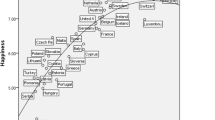Abstract
A model integrating the permanent income and relative income hypotheses was employed to explain consumer expenditure behavior in the U.S. The model was empirically tested using data from the interview survey portion of the 1996 and 1997 Consumer Expenditure Survey. The results indicate that household expenditure behavior is generally explained by both hypotheses when integrated in one model.
Similar content being viewed by others
References
Ando, A., & Modigliani, F. (1963). The life-cycle hypothesis of saving. American Economic Review, 53(1), 55-74.
Attanasio, O. P., Banks, J., Meghir, C., & Weber, G. (1999). Humps and bumps in lifetime consumption. Journal of Business and Economic Statistics, 17(1), 22-35.
Attanasio, O. P., & Weber, G. (1995). Is consumption growth consistent with intertemporal optimization? Evidence from the Consumer Expenditure Survey. Journal of Political Economy, 103(6), 1121-1157.
Boskin, M. J., & Sheshinski, E. (1978). Optimal redistributive taxation when individual welfare depends upon relative income. The Quarterly Journal of Economics, 92, 589-601.
Brady, D. S., & Friedman, R. D. (1947). Savings and the income distribution. In Studies in Income and Wealth (Vol. 10, pp. 247-265). New York: National Bureau of Economic Research.
Buhmann, B., Rainwater, L., Schmaus, G., & Smeeding, T. M. (1988). Equivalence scales, well-being, inequality, and poverty: Sensitivity estimates across ten countries using the Luxembourg Income Study (LIS) database. Review of Income and Wealth, 34(2), 115-143.
Duesenberry, J. S. (1949). Income, saving and the theory of consumer behavior. Cambridge: Harvard University Press.
Fan, J. X. (1997). Expenditure patterns of Asian Americans: Evidence from the U.S. Consumer Expenditure Survey 1980–1992. Family and Consumer Sciences Research Journal, 25(4), 339-368.
Fan, J. X. (2000). Linking consumer debt and consumer expenditure: Do borrowers spend money differently? Family and Consumer Sciences Research Journal, 28, 357-400.
Ferber, R. (1973). Consumer economics: A survey. Journal of Economic Literature, 11, 1303-1342.
Frank, R. H. (1985). The Demand for unobservable and other nonpositional goods. American Economic Review, 75, 101-116.
Friedman, M. (1957). A theory of the consumption function. Princeton: Princeton University Press.
Garner, T., & Blanciforti, L. (1994). Household income reporting: An analysis of U.S. Consumer Expenditure data. Journal of Official Statistics, 10(1), 69-71.
Greene, W. H. (1997). Econometric analysis. Upper Saddle River, NJ: Prentice Hall.
Hirsch, F. (1976). Social limits to growth. Cambridge: Harvard University Press.
Hirshleifer, J. (1985). The expanding domain of economics. American Economic Review, 75, 53-68.
Kosicki, G. (1987a). The relative income hypothesis: A review of the cross section evidence. Quarterly Journal of Business and Economics, 26, 65-80.
Kosicki, G. (1987b). A test of the relative income hypothesis. Southern Economic Journal, 54, 422-434.
Kosicki, G. (1990). Income redistribution and aggregate consumption: Implications of the relative income model. The American Economist, 34, 40-44.
Maddala, G. S. (1983). Limited-dependent and qualitative variables in econometrics. Cambridge, UK: Cambridge University Press.
Maddala, G. S. (1992). Introduction to econometrics. New York: Macmillan Publishing Company.
Paulin, G. D. (1995). A comparison of consumer expenditures by housing tenure. Journal of Consumer Affairs, 29(1), 164-198.
SAS Institute Inc. (1988). SAS/ETS user's guide version 6 (1st ed.). Cary, NC: SAS Institute Inc.
U.S. Bureau of Labor Statistics (BLS). (1996). Consumer Expenditure Survey: Interview survey and EXPN files. Ann Arbor, MI: Inter-University Consortium of Political Science Research.
U.S. Bureau of Labor Statistics (BLS). (1997). Consumer Expenditure Survey: Interview survey and EXPN files. Ann Arbor, MI: Inter-University Consortium of Political Science Research.
Author information
Authors and Affiliations
Rights and permissions
About this article
Cite this article
Fan, J.X., Abdel-Ghany, M. Patterns of Spending Behavior and the Relative Position in the Income Distribution: Some Empirical Evidence. Journal of Family and Economic Issues 25, 163–178 (2004). https://doi.org/10.1023/B:JEEI.0000023636.75717.61
Issue Date:
DOI: https://doi.org/10.1023/B:JEEI.0000023636.75717.61



